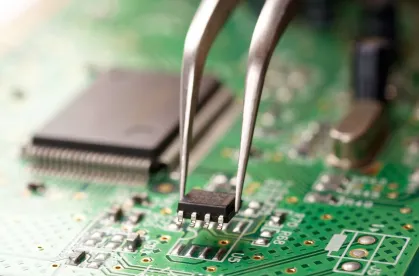The Announcement
On Friday, October 7, 2022, the U.S. Bureau of Industry and Security (BIS) released for public inspection (available here) one hundred forty pages of regulations (which we’ll call “the Regulation” here) that added and changed the Export Administration Regulations (EAR). Nearly all of the changes in the Regulation restrict the export of semiconductors, as well as related technology, manufacturing equipment, software, and even U.S.-person support, to China.
With apologies for the delay[1], we provide here a broad outline of the Regulation. We cannot pack every detail into this initial article, and it is also a bit hard to organize (though we’ve tried numbering and colors and things to help out!), but we want to make sure you have a sense of the scope of the incipient new restrictions.
We will fill in the twists, turns, and details throughout this week and next – in particular after we join the public briefing on the new regs that BIS will host on Thursday, October 13.
NB: There’s a lot here, but for the really wild part, skip right down to U.S. Person Restrictions in Section 3, below. As far as boring blogs about regulations goes, it is a thrilling read!
Publication and Implementation
The regulations will be published officially on October 13, 2022, with some of the rules already in effect on October 7. Other parts will take effect on October 12, on October 21, and still others are subject to a Temporary General License that will effectively push back the implementation date six months to April 7, 2023.
The Big Takeaways:
1. The Restrictions – Advanced Computing Integrated Circuits
1.1. The Commodities
The Regulation creates a new Export Control Classification Number for high-performance Integrated Circuits (ICs) and computers. The ECCN for the commodities is 3A090 and the software and technology for those commodities are tucked into 3D001 and 3E001, respectively. The Regulation also creates a new 4A090 for commodities containing 3A090 ICs. New 4D090 is created for software related to 4A090 commodities, and 4E001 is modified to include technology for 4A090 commodities. 5A990 and 5D992 are modified to include items exceeding the thresholds in new 3A090 or 4A090.
Generally, the technical parameter for the controlled ICs is defined by having or being programmable to have an aggregate bidirectional transfer rate over all inputs and outputs of 600 Gbyte/s or more to or from integrated circuits other than volatile memories, as well as one of the following:
-
One or more digital processor units executing machine instructions having a bit length per operation multiplied by processing performance measured in TOPS, aggregated over all processor units, of 4800 or more;
-
One or more digital ‘primitive computational units,’ excluding those units contributing to the execution of machine instructions relevant to the calculation of TOPS for 3A090.a.1, having a bit length per operation multiplied by processing performance measured in TOPS, aggregated over all computational units, of 4800 or more;
-
One or more analog, multi-value, or multi-level ‘primitive computational units’ having a processing performance measured in TOPS multiplied by 8, aggregated over all computational units, of 4800 or more; or
-
Any combination of digital processor units and ‘primitive computational units’ whose calculations, according to the descriptions above, sum to 4800 or more.
1.2. The Equipment
The Regulation controls IC manufacturing equipment separately from the commodity. That is—the ECCN 3B090 does not simply control equipment for manufacturing 3A090 ICs. Rather 3B090 controls a long and very specific list of semiconductor manufacturing deposition equipment.
1.3. The Controls
All of the 3×090 categories are controlled for Regional Stability reasons and license applications will be reviewed under a presumption of denial to China unless the end-user in China is headquartered in the United States or in a Country Group A:5 or A:6 Country (in which case it will be reviewed on a case-by-case basis).
Further, the Regulation also provides a Model Certificate (discussed below in Section 5) so that entities involved in transactions requiring (and eligible for) a license can obtain appropriate assurances as to the end use of their exports and those exports’ products (though, of course, BIS warns that such a certification may not constitute sufficient diligence on its own).
2. The Restrictions – New Foreign Direct Product Rules
The Regulation introduces not one, not two, but three—three!—new Foreign Direct Product Rules (FDP) (well, ok, one is a lot like an FDP we’ve already seen, so we’ll start with the new and interesting ones). Each of the FDP rules contains a “Product Scope” and a “Country and End-Use Scope” (hint: it’s China). Any item falling in both scopes will be subject to the FDP restrictions.
2.1. Advanced Semiconductor FDP
Product Scope. The Advanced Semiconductor FDP covers foreign-produced items that are
-
The direct product of technology or software subject to the EAR in more or less all the Categories 3, 4, and 5, Group D and E ECCNs (or the product of a plant or major component of a plant that is a direct product of such technology or software); and
-
Is a 3A090 item or is software or technology in the related Category 3 subcategories, 3D001 and 3E001, or is an item listed elsewhere in the CCL (like 5A002 because it has encryption), but meets the performance parameters of a 3A090 item.
Country and End-Use Scope. The FDP licensing requirement applies to items described above where there is knowledge that the foreign-produced item is:
-
Destined for the People’s Republic of China (PRC) or will be incorporated into any part, component, computer or equipment that is not EAR99 and is destined to the PRC; or
-
Is technology developed by an entity headquartered in the PRC for the production of a mask or IC wafer or die.
2.2. Supercomputer FDP
Product Scope. The Supercomputer FDP covers foreign-produced items that are
-
The direct product of technology or software subject to the EAR in more or less all the Categories 3, 4, and 5, Group D and E ECCNs (or the product of a plant or major component of a plant that is a direct product of such technology or software).
Country and End-Use Scope. The FDP licensing requirement applies to items described above where there is knowledge that the foreign-produced item is:
-
Used in the design, “development,” “production,” operation, installation, maintenance, repair, overhaul, or refurbishing of, a “supercomputer” located in or destined to the PRC; or
-
Incorporated into, or used in the “development,” or “production,” of any “part,” “component,” or “equipment” that will be used in a “supercomputer” located in or destined to the PRC.
Wait. We forgot to define Supercomputer! (see, we told you this was difficult to pack into an article!) A supercomputer is defined as a computing “system” having a collective maximum theoretical compute capacity of 100 or more double-precision (64-bit) petaflops or 200 or more single-precision (32-bit) petaflops within a 41,600 ft3 or smaller envelope. (There are a few explanatory notes as well, but we’ll get into those in a later article).
2.3. Entity List Footnote 4 FDP
Effective October 21, 2022, BIS has added a Footnote 4 designation to 28 Entities in China. All 28 of those parties were already designated on the Entity List, but did not have a footnote designation. Structurally and substantively, the new Entity List designation under Footnote 4 (FN 4) looks and functions a lot like Footnote 1 (FN 1). We will present the essential restrictions on entities designated in FN 4 here, but will parse the differences between FN 1 and FN 4 in a later article. We note that the Regulations do not alter the scope or requirements of the existing Entity List FDP rule applicable to FN1 entities.
Product Scope. The FN 4 FDP covers foreign-produced (non-U.S.) items that are the direct product of technology or software subject to the EAR in more or less all Categories 3, 4, and 5, Group D and E ECCNs (or the product of a plant or major component of a plant that is a direct product of such technology or software).
End-Use Scope. The FDP licensing requirement applies to items described above where there is knowledge that:
-
The item will be incorporated into, or used in the production or development of, any part, component, or equipment produced, purchased, or ordered by any FN 4 entity; or
-
Any FN 4 entity is party to any transaction involving the item.
If both the product and end-user scopes are met, the foreign-made item is considered subject to the EAR and the relevant licensing requirements apply.
3. The Restrictions – U.S. Person Support
Ok, so here’s the wild part: the EAR place direct restrictions on U.S. person support for the development of any chips if that support goes to a facility that produces advanced semiconductors (or even if you don’t know whether the facility produces advanced semiconductors!). (We note that the new bar for prohibiting the provision of information is so low, it functions almost as an EAR control against the provision of services, which will ring a bell for those familiar with U.S. economic sanctions and embargoes administered by the U.S. Office of Foreign Assets Control). Here are the details (with a little parenthetical commentary interspersed).
3.1. Support by U.S. Persons for PRC Facilities Fabricating High-Tech ICs (non-EAR items)
The Regulation provides notice that BIS will consider U.S. persons to be in violation of EAR §744.6 if they provide to China any item not subject to the EAR (see that? There is no floor there. That could be just about any information!) that they know will be used in the development or production of any integrated circuits (Note that one too. The information or items a U.S. person provides may be related to any low-level commercial-off-the-shelf IC) if those ICs will be produced at a semiconductor fabrication “facility” located in the PRC (Check out that defined term, facility. We’ll come back to that one) that fabricates ICs that meet the following criteria:
-
Logic integrated circuits using a non-planar architecture or with a “production” technology node of 16/14 nanometers or less;
-
NOT-AND (NAND) memory integrated circuits with 128 layers or more; or
-
Dynamic random-access memory (DRAM) integrated circuits using a “production” technology node of 18 nanometer half-pitch or less;
Note that, to be prohibited, the information and items provided by the U.S. person need not be used in the production of those advanced ICs. Rather, the information or items are prohibited merely if they are to be used in production at a facility that also produces the defined advanced ICs.
The prohibition then goes on to prohibit facilitating such a transaction and servicing such an item.
So, that’s what you cannot provide to a Chinese fabrication facility if you know it fabricates (interestingly, not that it is capable of fabricating, just that it fabricates) ICs at that high-technology level. But what if you don’t know whether or not it fabricates such ICs?
3.2. Support by U.S. Persons for PRC Facilities Where they Do NOT Know Whether the Facility Fabricates High-Tech ICs (non-EAR items)
Well, in a case where one does not know whether a PRC facility fabricates ICs that meet the criteria above or not, the bar is a little bit higher.
A U.S. person may not provide the PRC with any item that would be considered controlled under Category 3, Groups B, C, D, or E, of the EAR (so no IC machinery, materials, technology or software), if that person knows it will be used in the development or production of ICs in a facility where the person does not know what level of ICs the facility fabricates.
3.3. Support by U.S. Persons for PRC Facilities (EAR Items)
After reading the above, you may be thinking “well, that’s all fine. I’m just gonna provide items subject to the EAR. That sounds like it will be much easier!” Well, we are sorry to disappoint you. The new general prohibition in EAR §744.23 prohibits the exact same scope of activity for items that are subject to the EAR. So, the drafters have really covered all the bases.[2]
4. The Mitigation – Compliance Certifications, Savings Clauses, and a Temporary General License
The Regulation includes certain measures to minimize the short term impacts on supply chains (for those logistics and compliance persons at global semiconductor companies, we recognize that the word “minimize” does not really feel like the right word to use in this instance, but that’s what’s in the regs).
4.1. Certification of Compliance with New Advanced Semiconductor FDP Rule
The Advanced Semiconductor FDP rule provides that exporters, reexporters, and transferors may obtain a written certification from a supplier that asserts an item being provided would or would not be subject to the EAR if future transactions meet the scope of the definitions of the FDP rule.
The Regulation provides an actual template model certificate for that purpose. The regulations note that if exporters, reexporters and transferors fail to obtain certification from their suppliers, due diligence must be conducted to determine whether their items are covered by the Advanced Semiconductor FDP rule. However, BIS notes that the certificate, by itself, may also be considered insufficient due diligence on a transaction, so companies may need to go beyond the certificate with their diligence in any case.
4.2. Savings Clauses
As with many immediately-applicable regulations, a savings clause applies. That clause states that items subject to the new regulations that would now require a license, but were on dock for loading, on lighter, laden aboard an exporting carrier, or en route aboard a carrier to a port of export on October 7, 2022, may continue to the destination under the previous license exemption or without a license so long as they have been exported, reexported or transferred before November 7, 2022.
Further, the saving clause provides that deemed exports and reexports of technology and source code related to ECCNs 3A991.p and 4A994.l that did not previously require a license, will only require a license if the technology or software release exceeds the scope of the technology or software that the foreign national already had access to prior to the implementation of controls in the new Regulation. So, if you’ve already shared some information in those categories, that’s ok. You only need a license if you’re going to share more.
4.3. Temporary General License
With respect to the Advanced Semiconductor FDP rule, the Regulation provides a Temporary General License that authorizes from October 21, 2022 through April 7, 2023 exports, reexports, transfers, and exports from abroad destined to or within China by companies not headquartered in countries in Country Groups D:1, D:5, E:1, or E:2 to continue or to engage in integration, assembly (i.e. mounting), inspection, testing, quality assurance, and distribution of items covered by ECCNs 3A090, 4A090, 3D001 (for 3A090 or 4A090 items), 3E001 (for 3A090 or 4A090 items), 4D090, or 4E001 (for 3A090 or 4A090 items), or items specified elsewhere on the CCL that meet or exceed the performance parameters of ECCNs 3A090 or 4A090.
BIS notes that the new Temporary General License does not authorize the export, reexport, transfer, or export from abroad to end-users or ultimate consignees in China. Further, the Temporary General License does not overcome the license requirements applicable to prohibited end uses or end users, including the ones identified with a FN 4 designation on the Entity List.
More to Come!
As the title of this post suggests, this is only the first dip of our toes into the delightful and welcoming waters of new semiconductor regulations. In the coming weeks we will elicit some details on the regulations from BIS (Thursday), gauge the reaction from China (not great?), and answer some more nuanced questions like:
-
Can my U.S. employees still talk with our Chinese suppliers, customers, or contract manufacturers?
-
What about a U.S. person who works for a Chinese semiconductor company?
-
What can I do from the EU without triggering some of these extraterritorial elements?
. . . and many, many more. As ever, we welcome your questions and comments at the contact information of the authors. There will be much to discuss as this regulation goes into effect and develops into a new way of doing business in the semiconductor industry.
FOOTNOTES
[1] Between a red-eye flight and two children under 3, the lead author has to admit that reading through regulatory minutiae over the weekend had a decidedly soporific effect.
[2] We would remark here that the Regulation, hate it or loathe it, is an incredibly complex and well-organized piece of drafting. Assistant Secretary Rozman Kendler and her team deserve credit for their attention to detail (before, of course, we, and the entire industry, start groaning about the restrictions and asking BIS a million questions about their application).





 />i
/>i

